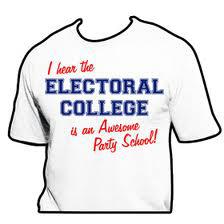
With the presidential election so close, the question arises: what if the electoral college result is a 269-to-269 tie? It could happen. Yesterday's analysis of the state of the race began by putting in Obama's column the 242 electoral votes of the eighteen states (and the District of Columbia) that have gone Democratic for five elections in a row. Then I added New Mexico and Ohio, to put Obama at 265. If he also won New Hampshire's four electoral votes, but lost all the others that appear close (Viginia, Iowa, Colorado, Florida, North Carolina, and Nevada), we'd have a tie.
The Twelfth Amendment covers the case:
The person having the greatest Number of votes for President, shall be the President, if such number be a majority of the whole number of Electors appointed; and if no person have such majority, then from the persons having the highest numbers not exceeding three on the list of those voted for as President, the House of Representatives shall choose immediately, by ballot, the President. But in choosing the President, the votes shall be taken by states, the representation from each state having one vote; a quorum for this purpose shall consist of a member or members from two-thirds of the states, and a majority of all the states shall be necessary to a choice. And if the House of Representatives shall not choose a President whenever the right of choice shall devolve upon them, before the fourth day of March next following, then the Vice-President shall act as President, as in the case of the death or other constitutional disability of the President.
The person having the greatest number of votes as Vice-President, shall be the Vice-President, if such number be a majority of the whole number of Electors appointed, and if no person have a majority, then from the two highest numbers on the list, the Senate shall choose the Vice-President; a quorum for the purpose shall consist of two-thirds of the whole number of Senators, and a majority of the whole number shall be necessary to a choice.
Notice two things. First, the state delegations in the House choose how to allot their state's one vote. That is to say, after the one representative from Wyoming and the 53 representatives from California had expressed their preference, the tally that counts would be 1 to 1. And Idaho would cancel New York. And Vermont, Texas. You might say, with fairness, that if the electoral college at first renders no verdict the tie-breaking solution is to attach an exponent to the original undemocratic calculations. It would be terrible even if it wasn't the case that it would boost Romney into the White House.
Second, there is the possibility that the president and vice president would be of different parties. That is because the House chooses the president, and the Senate chooses the vice president. Since this year it appears likely that the Dems will retain control of the Senate, while Romney, propelled by Alabama and Alaska, would prevail in the House, we could end up with a Romney-Biden administration. How would that work? A bill that Romney wanted might come to grief when Biden casts a tie-breaking vote in the Senate. Possibly some "statesmen," by means of some kind of bizarre "deal," could avert this even more bizarre outcome. But these would be the same statesmen who have failed to abolish this wretched Rube Goldberg machine.
I'm not even going to raise the specter of a "faithless elector."
National Popular Vote. If like me you do not live in Vermont, Maryland, Washington, Illinois, New Jersey, D.C., Massachusetts, California, or Hawaii (the states that have joined the ingenious pact), contact your state legislator.
